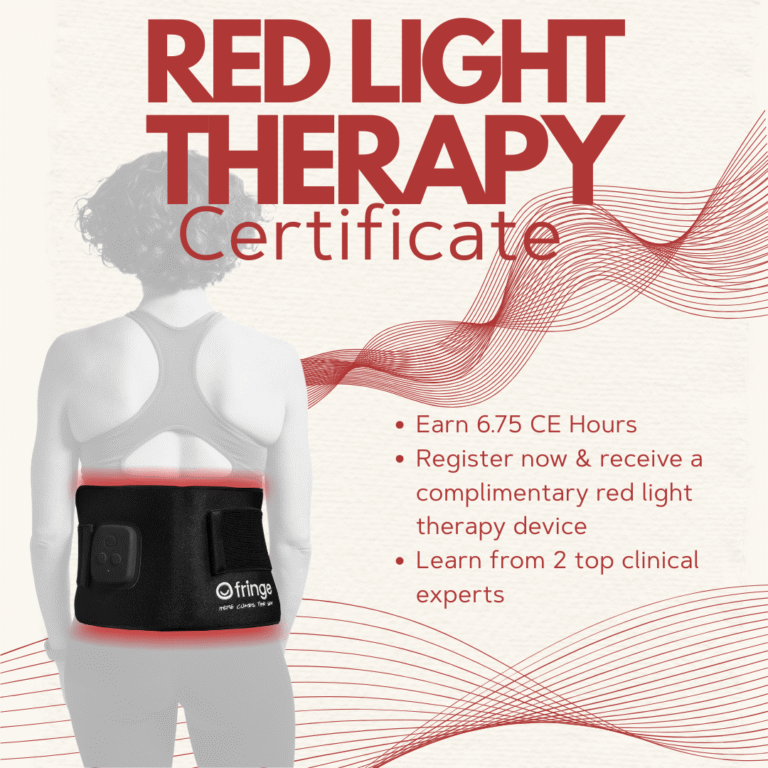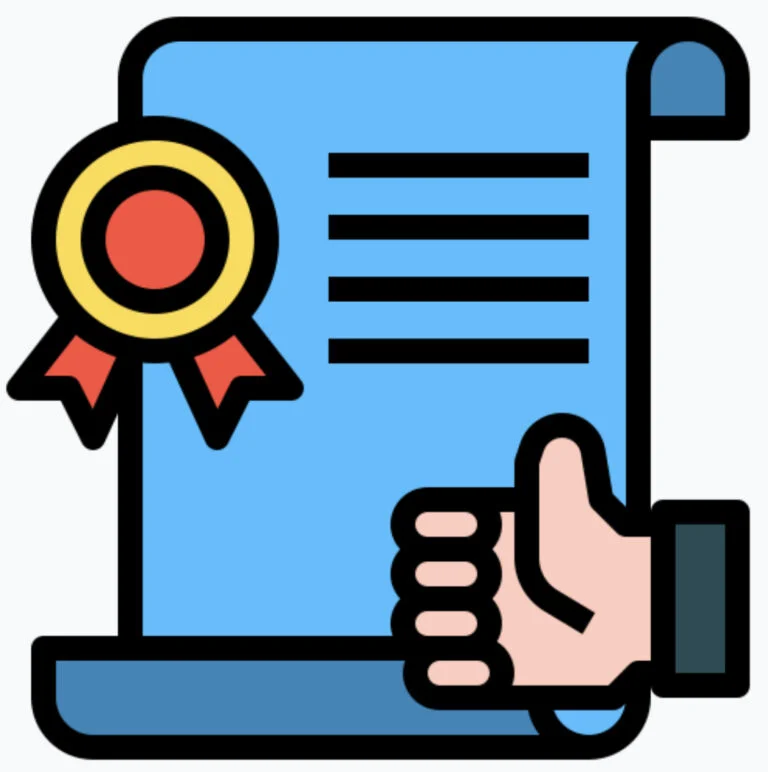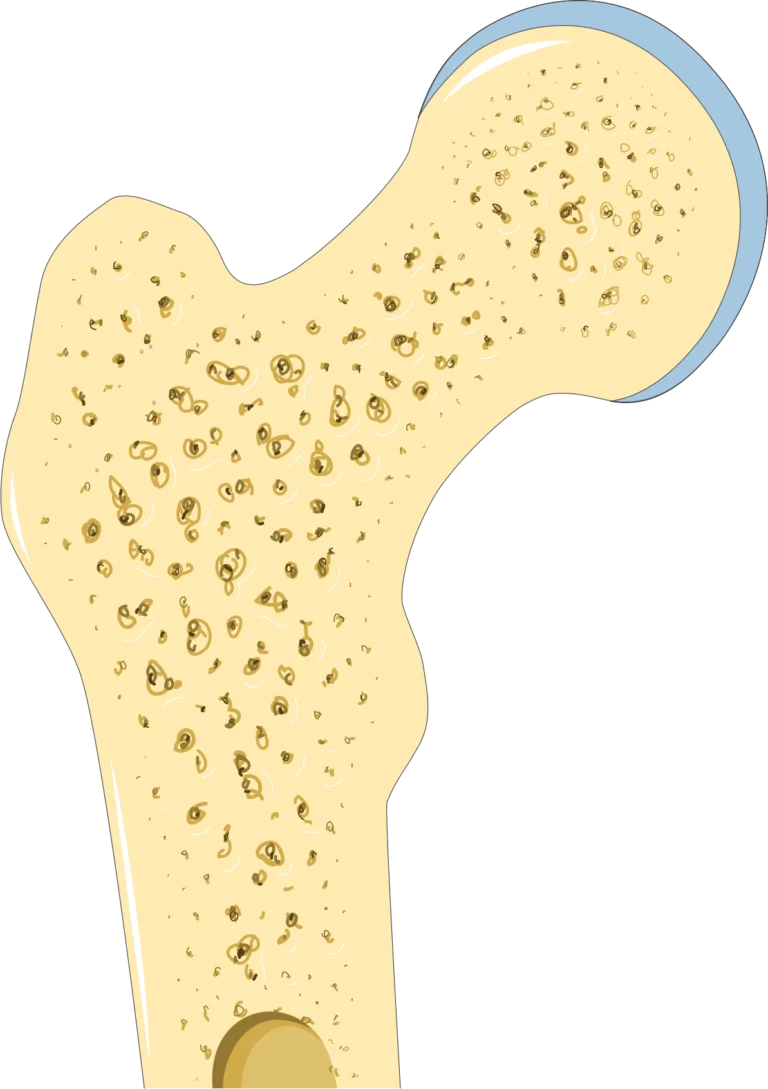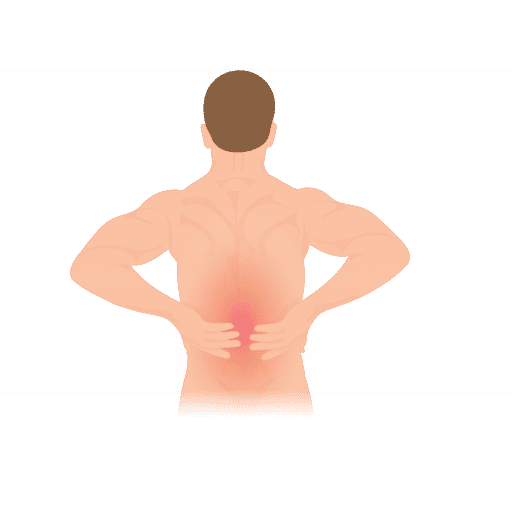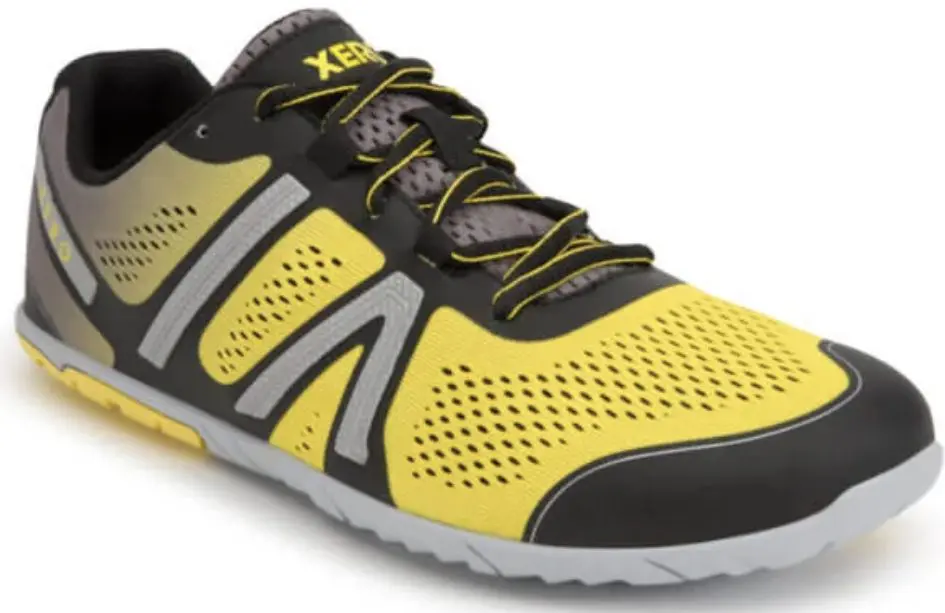The Brookbush Institute CPT (Certified Personal Trainer) program is one of the most comprehensive programs available. Unlike other leading CPT programs, this one is not easy, but it does prepare you to guide another’s fitness journey.
In our review of the Brookbush Institute CPT program, we wrote that a major aspect that is missing is an overview or guide of the entire certification and process, and that’s why we composed this Guide to the Brookbush Institute’s Certified Personal Trainer Program.
Below you’ll find an overview of the program as well as our recommendation for how to get the most out the Brookbush Institute’s Certified Personal Trainer Program.
Be sure to also read our Brookbush Institute Review: 2 Great Online Certifications!
Healthy feet…great price!
- Fast shipping for $3-5
- Great variety
- Long-lasting quality
- Add lace-locks for quick changes

Try minimalist shoes from XeroShoes.com!
Overview of Brookbush Institute’s Certified Personal Trainer (CPT) Program
Some information about the certification program as a whole is covered in our review. Here we’ll focus on the content more than the user experience.
A major strength of the Brookbush Institute’s CPT program is the centrality of the Overhead Assessment Test. This allows the trainer to have a good look at a client’s bad muscular patterns or weaknesses. Then the program gives you the tools to construct sessions with your clients.
Although the exercises are taken more from physical therapy and strength and conditioning approaches, these are all very compatible with Pilates teaching.
This CPT program can be used by everyone from newbies to physical therapist. If you are a newbie, you’ll need to start in with the “Beginners” path advised under Step 1 (below). By the time you’re reading and listening to the material in later categories, the Brookbush Institute supposes you have a good understanding of anatomical vocabulary.
Structure of the Program
7 Categories, total of 50 credit hours

- Introduction to Functional Anatomy: 9 hours
- Integrated Functional Anatomy of Muscles: 3 hours
- Overhead Squat Assessment: 4 hours
- Corrective Exercise: 5 hours
- Strength and Performance Training: 18 hours
- Research Corner: 1 hour
- Electives: 10 hours
Each category has a number of lessons that you can choose from. These lessons are still being added, which is a great feature of the course.
Lessons are both text, images, and video. The anatomy content is generally text, and it can be quite dense (with discussion of leading contemporary scientific studies). The videos are easy to follow demonstrations of exercises and stretches.
To receive credit for a lesson, you must successfully complete a test.
Step 1: The Introduction to Functional Anatomy Category
Required hours: 9
Current number of lessons to choose from: 22 (1 credit hour each)
Make sure you’re clear on the vocabulary and concepts you’ll need to get the most from the course by completing the Introduction to Functional Anatomy first. This is a priority if you’re a beginner with anatomy, but there are also lessons that will be instructive for more advanced students.

Beginners
Most of the articles presuppose that you have a familiarity with anatomical language. Do these words confuse you:
- Proximal
- Medial
- Antero-lateral
- CNS
If so, you’ll want to start out with the Introduction to Functional Anatomy courses. Be sure to complete the first five lessons:
- Anatomical Position & Anatomical Directions
- Planes of Motion
- Joint Actions
- Synovial Joints
- Human Movement Systems
After this you have four credit hours remaining in your Functional Anatomy requirement. I’d highly recommend:
- “Functional Roles of Muscles,” which goes over how muscles work together
- “Introduction to Human Movement Assessment and Analysis,” which is a great lead in to the Brookbush Institute’s approach to movement
Intermediate
If you already have a firm basic understanding of anatomical language, start with the last two lessons listed above. Then you might want to focus on certain areas of the body for the Introduction to Functional Anatomy module. (Pilates instructors might be particularly interested in the lessons “The Spine and Trunk Muscles” and “Trunk Muscles Graph, Additional Core Muscles and Core Exercise Challenge.”) The Brookbush Institute’s certified personal trainer program has topics in this module that literally cover head to toe, so enjoy!

Step 2: Integrated Functional Anatomy of Muscles
Required hours: 3
Current number of lessons to choose from: 30 (all 2 hours; all also count toward Human Movement Specialist Certification)
While only three hours are required to meet the requirements of the Integrated Functional Anatomy of Muscles section, this is a good section to spend some time in before you move on. First, in order to get the most from the Overhead Squat Assessment section, you need to have a good understanding of how many muscles work individually and in relationship with others. Second, all of these credits work toward the same section in the Human Movement Specialist certification. Third, you can count these toward your elective credits.
In order to get the most out of the Overhead Squat Assessment section, I’d recommend you complete these lessons:
- Gluteus maximus
- Internal obliques
- External obliques
- Tensor fascia latae
- Adductor muscles
- Biceps femoris
- Latissimus dorsi
The muscles listed above are complicated: some are over-active, some under-active, and others have multiple functions depending on how the body is positioned. So it’s worth your time to get clear on how these muscles work.
Purchase from bookshop.org. Support bookstores!
Step 3: Overhead Squat Assessment
Required hours: 4
Current number of lessons to choose from: 2 (all 2 hours; also counts toward Human Movement Specialist Certification)
You are now in a good position to make the most of a fundamental component of the Brookbush Institute’s approach to fitness: the Overhead Squat Assessment.
Rather than just giving a client a generic workout program, using the Overhead Squat Assessment as the tool for identifying your client’s weaknesses allows you to create a customized program for your client. The centrality of the Overhead Squat Assessment with the Brookbush Institute’s Certified Personal Trainer program makes it stand out head and shoulders over other programs.
For Pilates instructors, it will also improve your visual assessment skills and give you great information for areas to hit in your sessions.
What is an Overhead Squat Assessment?
In the Overhead Squat Assessment, the client will squat with their arms over their head. The trainer then looks for compensation patterns, including:
- Leaning forward
- Knees bowing out
- Feet rolling in
- Shifting in the hips
You’ll then create a training program based on what you see. For example, if the feet roll in, you’ll need to look at strengthening the feet’s arches and lengthening the lateral tibial muscles. The Brookbush Institute has tons of specific exercises for lengthening, strengthening, and releasing (see section below).
They also provide principles for you so you can make results-oriented sessions with your clients.
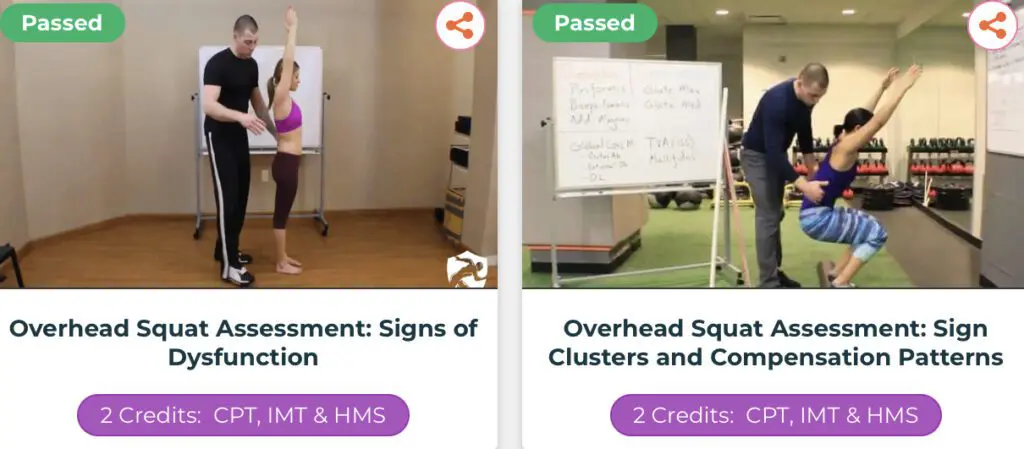
Why is an Overhead Squat Assessment helpful for clients?
The Overhead Squat Assessment allows you to 1) identify weaknesses in your client, 2) identify muscles that may be responsible for unsafe compensation patterns, 3) structure a session that would address one issue at a time.
This allows you to construct a results-based session with your client. They can see the problem and some improvement in that area by the end of the session. You can start up with that same area in your next session together to see whether the improvements held from one meeting to the next.
Rather than asking your client, “What do you feel like doing today?”, this method gives you a quick way to structure your sessions, chart progress, and facilitate your client’s improvement in functional movement.
Healthy feet…great price!
- Fast shipping for $3-5
- Great variety
- Long-lasting quality
- Add lace-locks for quick changes

Try minimalist shoes from XeroShoes.com!
Step 4: Remaining Sections
After you have taken the time to understand how an Overhead Squat Assessment works, you can start mapping out session plans for clients with different conditions. There are three major pieces here:
- What exercises should you give the client (and avoid)?
- How do you structure the pacing of a session based on your client’s needs?
You’ll learn to address these questions as you earn your remaining credits.
Corrective Exercises
Required hours: 5
Current number of lessons to choose from: 23 (1-2 credit hours; most also count toward Human Movement Specialist Certification)
Here you begin learning the specific exercises you’ll need to help your clients. These are the subsections under the “Corrective Exercise”:
- Mobilty
- Joint mobilization
- Activation
- Subsystem integration
Strength and Performance Training and Core Progressions
Required hours: 18
Current number of lessons to choose from: 25 (1 hour each)
The subsections here are:
- Exercise Physiology
- Strength Training Progressions
- Core Progressions
Most of these lessons look at more full-bodied exercises, such as chops and standing rows. The lessons in this category build upon the more muscle-specific approach of the lessons in the Integrated Functional Anatomy of Muscles category.
These are only 1 credit hour each, so you’ll need to do 18 lessons. They’re all very interesting and give you a lot of great exercises, so you’ll come out with many tools in your toolbox!
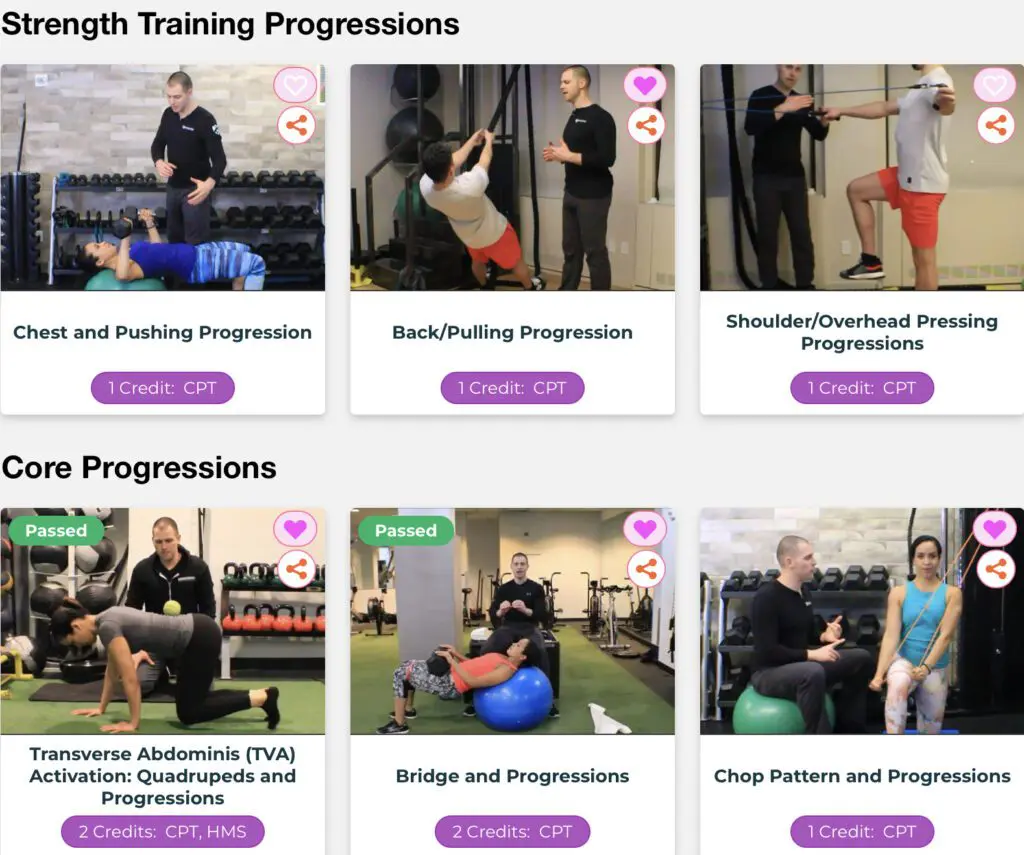
After this, you have 1 hour from the “Research Corner” and 10 from the “Elective” categories.
Teaching Tips: How do I Process all this Information?
This CPT program gives you a lot of information. And unless you have a photographic memory, it’s going to be impossible to retain it all (at least from the beginning).
So here are three ways you can immediately begin to incorporate what you’re learning. Once you are familiar with some of the material, you can move on to the next. Little by little, you can work confidently within a large field of knowledge.
Prepare for the next day
If a client has weaknesses or compensation patterns you’re already aware of, prepare that material. Rather than preparing for every muscle and movement, get clear on the few you’ll be looking at tomorrow.
Have a few standbys
Regardless of how long you’ve been in the fitness industry, you’ll quickly find some areas that need improvement in 90% of your clients. These are some good areas for you to be familiar with:
- Plank progressions
- Glute Maximus Activation
- Tensor Fasciae Latae and Vastus Medialis lengthening and inhibition
- Deadlift progressions
- Hip flexor stretches
Group clients according to focus
Last, you might want to group your clients according to your area of focus. So in the morning, you might take 3-4 clients through plank progressions, then schedule your afternoon with clients who need to increase hip flexor flexibility. You can prep your hip flexor material over lunch.
Healthy feet…great price!
- Fast shipping for $3-5
- Great variety
- Long-lasting quality
- Add lace-locks for quick changes

Try minimalist shoes from XeroShoes.com!
Conclusion
The Brookbush Institute CPT (Certified Personal Trainer) program is one of the best online CPT programs out there. This guide should help you navigate the program and find the lessons that are most relevant to you.
The material in the Brookbush Institute CPT is great for Pilates and yoga instructors, particularly if there’s a rehabilitative aspect to your work. The muscle activation and lengthening/flexibility aspects will be very helpful for post-rehab clients.
Once you get familiarity with the Overhead Squat Assessment, it will be a great tool for you to know where to start with clients. It also serves as a benchmark you can go back and revisit after a session. This gives a great before-and-after for results-oriented clients.
Finally, the cost for the Brookbush Institute CPT (Certified Personal Trainer) program is great. You can pay monthly or get a big discount for a year. If you’re wanting to continue to the Human Movement Specialist certification, you might want to take the plunge and pay for a year in advance.
